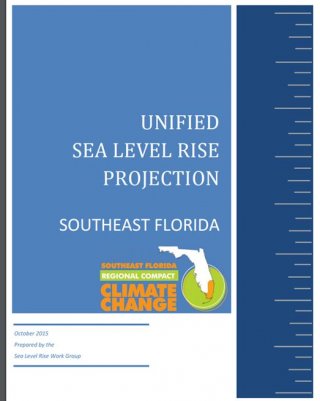Southeast Florida Compact Analyzes Sea Level Rise Risk

Southeast Florida, with a large population located at low elevation, is among the most vulnerable regions of the country to hazards and impacts such as sea level rise, flooding, and extreme weather events. The region is comprised of four counties (Monroe, Miami-Dade, Broward, and Palm Beach) that share similar geographic traits and coastal vulnerabilities.
Rather than separately attempting to identify climate projections and vulnerabilities, leaders of these counties recognized an opportunity to collaborate and identify impacts and vulnerabilities across the region.
A first step was to standardize projections and map sea level inundation. This single region-wide effort brought core stakeholders from counties, regional water management organizations, local universities and federal agencies together to create a regional vulnerability assessment of inundation and flooding. The resulting regional map identified vulnerable infrastructure, including drinking water and wastewater utilities, and was instrumental in informing development of the South Florida Regional Climate Action Plan.
The Regional Action Plan "A Region Responds to a Changing Climate" provides a comprehensive set of recommendations for local governments, focusing on sectors such as transportation, natural resource management, emergency management, and the water sector among others. The Regional Action Plan recommendations on water supply, management and infrastructure protection efforts has since been supplemented by the implementation guidance on "Integrating Climate Change & Water Supply Planning in Southeast Florida".
The Compact counties, municipalities, and other organization continue to collaborate on updates to environmental projections, including a recent 2015 Sea Level Rise Update, and other common adaptation resources.
- South Florida Regional Climate Action Plan (PDF)(84 pp, 4 MB, About PDF)
- Integrating Climate Change & Water Supply Planning In Southeast Florida (PDF)(24 pp, 3.3 MB)
| How Did They Do It? | Applicable EPA Tools |
|---|---|
Collaborated with neighboring jurisdictions to develop a vulnerability assessment
| The "Being Prepared for Climate Change Workbook" outlines how communities of any size can take appropriate steps to develop a vulnerability assessment and risk-based adaptation plan. For more on illustrating vulnerability to a range of potential sea level rise and storm surge scenarios, view the EPA Coastal Inundation Coastal Storm Surge Scenario that illustrates hurricane strike frequency and worst-case coastal storm surge or inundation scenarios. |
Encouraged and informed regional action
| Adaptation Strategies Guide helps communities identify potential adaptation strategies and inform actions for infrastructure located in coastal areas. |
Similar Cases and More Information
A community does not always have to develop new information or data. For an example of a community that used existing sources of information to guide decision making, see Anacortes, Washington Rebuilds Water Treatment Plant for Climate Change.
Many communities in the southeast may have to deal with challenges to their source water – whether it is saltwater intrusion, sea level rise, or threats to the facility infrastructure. To learn how a utility is adapting to ensure source water availability, view Tampa Bay Diversifies Water Sources to Reduce Climate Risk.
To learn more about the South Florida Compact, visit the Climate Resiliency Toolkit’s Collaboration Among Counties Improves Vulnerability Assessments case study.
References
The following links exit the site:
- Integrating Climate Change & Water Supply Planning In Southeast Florida (PDF) (25 pp, 4 MB)
- Adaptation Action Areas: Policy Options for Adaptive Planning for Rising Sea Levels (PDF) (35 pp, 1 MB)
- A Region Responds to a Changing Climate, Regional Climate Action Plan (PDF) (84 pp, 4 MB)
- Analysis of the Vulnerability of Southeast Florida to Sea Level Rise (PDF) (181 pp, 8 MB)
- Unified Sea Level Rise Projection (PDF) (37 pp, 538 K)

